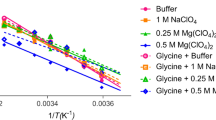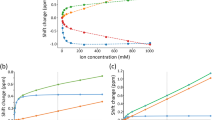Abstract
IT has been shown that bovine pancreatic ribonuclease may be dissolved in organic solvents with full recovery of the activity after removal of the solvent1. We have found that ribonuclease A retains its activity in the presence of high concentrations of many organic solvents and have utilized this property for investigating its mode of action. If the solvent used is methanol then the products of the action of ribonuclease on cytidine-2′,3′-phosphate are cytidine-3′-phosphate and cytidine-3′-phosphate methyl ester as previously observed by Heppel and Whitfeld2. As the mole fraction of methanol is raised, methanolysis increases and hydrolysis decreases as shown in Fig. 1. This behaviour is consistent with competition between methanol and water for a site on the enzyme.
This is a preview of subscription content, access via your institution
Access options
Subscribe to this journal
Receive 51 print issues and online access
$199.00 per year
only $3.90 per issue
Buy this article
- Purchase on Springer Link
- Instant access to full article PDF
Prices may be subject to local taxes which are calculated during checkout
Similar content being viewed by others
References
Sage, H. J., and Singer, S. J., Biochim. Biophys. Acta, 29, 663 (1958).
Heppel, L. A., and Whitfeld, P. R., Bioctem. J., 56, 1 (1954).
Author information
Authors and Affiliations
Rights and permissions
About this article
Cite this article
FINDLAY, D., MATHIAS, A. & RABIN, B. Activity of Bovine Pancreatic Ribonuclease A in Mixed Solvent Systems. Nature 187, 601–602 (1960). https://doi.org/10.1038/187601a0
Issue Date:
DOI: https://doi.org/10.1038/187601a0
This article is cited by
-
�ber die Ribonuclease der Milch
Zeitschrift f�r Lebensmittel-Untersuchung und -Forschung (1969)
-
Chromatography of the Proteins from Wheat Flour soluble in Acetic Acid
Nature (1961)
-
The Active Site and Mechanism of Action of Bovine Pancreatic Ribonuclease
Nature (1961)
Comments
By submitting a comment you agree to abide by our Terms and Community Guidelines. If you find something abusive or that does not comply with our terms or guidelines please flag it as inappropriate.



